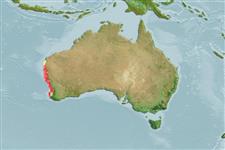Common names from other countries
Environment: milieu / climate zone / depth range / distribution range
Ecologia
; intervalo de profundidade 0 - 120 m, usually 0 - 90 m. Subtropical, preferred 22°C (Ref. 107945); 22°S - 34°S, 113°E - 116°E (Ref. 4)
Indo-West Pacific: restricted to Western Australia.
Length at first maturity / Tamanho / Peso / Idade
Maturity: Lm 7.0 range ? - ? cm Max length : 40.0 cm TL macho/indeterminado; (Ref. 4)
It has lengths of 40 cm, total body length; 14 cm, minimum carapace length; 8 and 10 cm, average carapace length; 9 to 11 cm, carapace length of ovigerous females or those with spermatophores (Ref. 4). The Western Australian Rock Lobster Fishery of this species has been certified by the Marine Stewardship Council (http://www.msc.org/) as well-managed and sustainable (http://www.msc.org/html/content_1277.htm). Occurs at depths between 0 and 90 m, rarely as deep as 120 m. The species are nocturnal and shelter in the daytime in rock crevices and among coral. They are omnivorous. They undertake limited migrations (Ref. 4). Juveniles spend 5 to 6 years in shallow-water reef areas, then moves offshore. They return from nocturnal foraging to the same den or one nearby, implying knowledge of topography (Ref. 106918). Phyllosomata of this species is observed to hitch and feed on its host salp Thetys vagina (Ref. 108806). Feeds on the coralline alga Corallina cuvieri (Ref. 122156).
Life cycle and mating behavior
Maturidade | Reprodução | Desova | Ovos | Fecundidade | Larvas
Brood and pelagic period lasts for 1.5 (Ref. 81134) and 10 months (Ref. 81163), respectively.
Holthuis, L.B. 1991. (Ref. 4)
Categoria na Lista Vermelha da IUCN (Ref. 130435)
Categoria CITES (Ref. 108899)
Not Evaluated
Not Evaluated
Utilização humana
Pescarias: espécies comerciais
FAO - pescarias: landings | FishSource | Sea Around Us
Ferramentas
Fontes da internet
Estimates based on models
Preferred temperature
(Ref.
115969): 20.2 - 24.2, mean 22.3 (based on 78 cells).
Resiliência
Baixo, tempo mínimo de duplicação da população 4,5 - 14 anos (K=0.09; tm=5).
Prior r = 1.15, 95% CL = 0.76 - 1.73, Based on 3 data-limited stock assessments.
